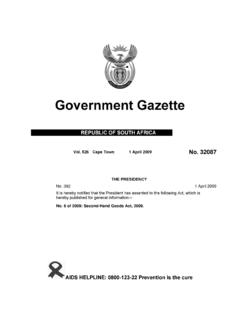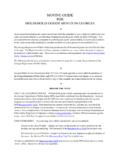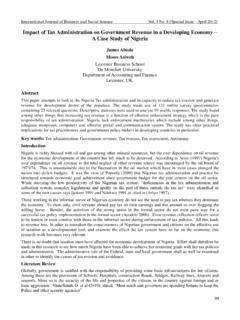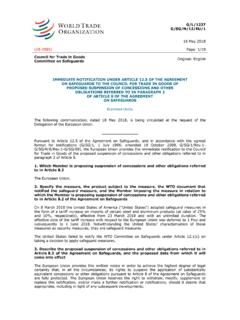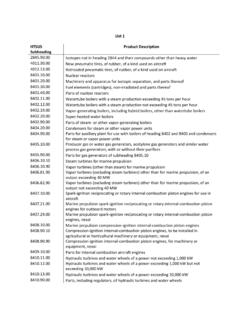Transcription of Corruption in Tax Administration - World Bank
1 9. Corruption in Tax Administration mahesh c. purohit orruption has always been in existence, in one form or C another. As far back as the fourth century BCE, Kautiliya, a Sanskirt scholar, wrote, Just as it is not possible not to taste honey (or poison) placed on the surface of the tongue, even so it is not possible for one dealing with the money of the king not to taste the money in however small a quantity. Just as fish moving inside water cannot be known when drinking water, even so officers appointed for carrying out works cannot be known when appropriating money (Kangle 1972: 91). Kautiliya points out the ways in which employees can be involved in Corruption and prescribes the modus operandi to be adopted by the king to deal with Corruption and make appointments. Broadly speaking, Corruption can be classified into five categories: political Corruption , administrative Corruption , grand Corruption , petty Corruption , and patronage/paternalism and being a team player.
2 In this chapter the term is defined to include pecuniary or nonpecuniary considerations given to government officials for the use of public office for private Activities that lead to personal benefit that do not involve the government or a quid pro quo are not examined here. The scope of this chapter is confined to Corruption in tax Administration . The chapter is divided into five sections. The first 285. 286 Mahesh C. Purohit section focuses on the main causes of Corruption in tax Administration . The second section presents issues related to Corruption in tax Administration and analyzes the role of procedures for administering custom duties, excise duties, and value added tax (VAT). The third section reviews the impact of Corruption on the economy. The fourth section suggests policy measures for combating Corruption in tax Administration . It highlights how the design of the tax structure and procedures of tax Administration can reduce the risk of Corruption .
3 The last section summarizes the chapter's conclusions and recommendations. Causes of Corruption in Tax Administration A variety of factors contribute to Corruption in tax Administration (box ). These include the complexity of tax laws and procedures, the monopoly power and degree of discretion of tax officials, the lack of adequate moni- toring and supervision, the commitment of political leadership, and the overall environment in the public sector. Complexity of Tax Laws The complexity of tax laws and procedures increases the magnitude of Corruption in the tax system. Tax evasion is more likely to occur in a highly corrupt environment. Lack of requisite information makes taxpayers unaware of their rights and more exposed to discretionary treatment and exploitation. B O X 9 . 1 Causes of Corruption in Tax Administration in Bulgaria A survey in Bulgaria reveals that the main drivers of tax Corruption are low pay, lack of professional ethics, legal loopholes, conflicts of interest, get-rich- quick ambitions, and bureaucratic red tape.
4 The less satisfied tax officers are with their pay scales or with the fairness of career development and financial incentive schemes, the more inclined they are to engage in corrupt behavior. If their wages are comparable to the wages for a similar job in the private sec- tor, they may not take the risk of engaging in Corruption . However, if their wages are too low to support themselves and their dependents, the incentives for Corruption rise. Tax officers' attitudes to Corruption are also conditioned by the severity of the punishment for corrupt behavior and the likelihood of being punished when detected. Taxpayers do not play a significant role in determining corrupt practices. Source: Pashev 2005. Corruption in Tax Administration 287. Monopoly Power and the Discretionary Power of Tax Officials Tax officers are allotted a particular geographical area of operations. For a particular taxpayer, the tax officer is the tax department.
5 This monopoly power gives tax officers the opportunity to create circumstances that entice taxpayers into corrupt practices. A lack of clearly defined roles, functions, and duties of public officials creates an environment ripe for abusive behavior (Pashev 2005). A high degree of discretionary power and the lack of adequate monitoring and reporting mechanisms are vital in providing opportunities for Corruption . The greater the discretion, the greater the opportunity tax officials have to provide favorable interpretations of government rules and regulations to businesses in exchange for illegal payments. Lack of Monitoring and Supervision Because of asymmetrical information, it is difficult to monitor officers and hold them accountable for their actions. The absence of supervision and accountability gives workers an opportunity to refrain from performing public duties. The absence of measures designed to maintain the integrity of staff such as the promotion and enforcement of ethical standards, merit- based recruitment and promotion procedures, and regular staff rotation schemes to prevent the creation of lucrative networks increases the likeli- hood of staff indulging in corrupt practices.
6 Unwillingness of Taxpayers to Pay Taxes In some developing countries, such as India, the extreme unwillingness of taxpayers to comply with the law and hence their readiness to bribe tax collectors in order to reduce their tax liability are important causes of cor- ruption. Many taxpayers are willing to abet tax collectors if there is clear gain. This phenomenon is common in many middle-income countries. Political Leadership Political leadership sustains and often creates and protects Corruption . Corrupt political leadership makes the spread of Corruption at lower levels relatively easy. A hierarchy of administrative levels is typically associated with different corrupt transactions. In the case of fiscal incentives, for example, relatively high-level officials and politicians are more likely to be involved in corrupt practices. In the case of foreign trade taxes and other routine activities, 288 Mahesh C. Purohit lower-level officials are also likely to be involved, sharing their illegal gains with those higher up in the chain of authority.
7 It is these routine cases of lower-level corrupt tax practices that ultimately erode public confidence in governmental institutions. For this reason, these practices are often seen as more corrosive than abuse of power at higher levels (Asher ) As the power of a leader evolves into the political management of a service, the indepen- dence of officials is rapidly eroded by the interference of political leaders, and the risk of Corruption increases. Political appointments not only reduce work efficiency, they also facilitate Corruption , as they did in Tanzania, where entrance into the police or the legal profession required joining the party (Sedigh and Muganda 1999). Overall Government Environment The level of Corruption in tax Administration generally parallels that in the administrative environment as a whole. Liberal economic systems offer fewer opportunities for Corruption than socialist systems. The greater the administrative controls over the economy, the greater the problems of mon- itoring and accountability, because a greater share of economic planning decisions depend on Administering Tax Policy The objectives of a tax policy can be achieved only when the policy is prop- erly administered.
8 Most developing countries face various organizational and operational constraints to effective tax Administration (box ). In these countries, tax Administration plays a crucial role in determining the real (or effective) tax system: tax Administration is tax policy (Casanegra de Jantscher 1990). Failure to properly administer the tax, therefore, defeats its purpose and threatens the canon of equity. It allows the government to collect taxes only from easy-to-tax sectors and people who cannot avoid paying. According to the business process model, the main factor causing Corruption in tax Administration is procedures. The greater the procedural interaction with the taxpayer, the greater the possibility of Corruption . Customs Duty Corruption in customs Administration is a major problem in many devel- oping countries. Case studies of Mali and Senegal, for example, indicate that Corruption in Tax Administration 289. B O X 9 . 2 The Nature of Tax Fraud in India An empirical study based on fieldwork conducted in 1994 95 indicates that tax evasion in India occurs partly through collusion between taxpayers and tax officers.
9 Of 5,840 offenses detected, 87 percent were procedural. These offenses included incomplete or insufficient documentation, inappropriate use of credit on capital goods, inadmissible deduction of inputs, taking of credit before the commencement of production, use of undeclared inputs, faulty interpretation of notification issued by the department, use of unreg- istered dealer's invoices, extension of credit on endorsed invoices, declaration of invoices with incorrect address, and submission of invoices that were not in the name of the unit. Substantial violations accounted for 7 percent of total revenue loss. These violations included irregular use of deemed credit, extension of credit on exempted final products, rejected inputs sent back without reversal of credit, extension of credit on basic customs duty, misuse of the facility of job work, excess credit taken, and the use of the CenVAT (the federal VAT) credit by small-scale units that had opted out of the system.
10 Fraudulent violations accounted for 6 percent of total revenue lost. These violations included extension of credit without producing the required documents, extension of credit on invoices without physical movement, duplicate extension credit on the same invoice, extension of credit without payment of duty, and use of fraudulent documents. These violations show a deliberate attempt on the part of the taxpayer to defraud the government. Source: Shome, Mukhopadhyay, and Saleem 1997. these countries have faced serious problems of customs fraud in recent years (Stasavage and Daubree 1998). Customs Administration in India has been reformed over time. Some problems remain, however. One relates to the valuation of cargo. Taxpayers are often harassed on the grounds that the valuation is not correct; on this pretext, goods are detained. Importers usually compromise on the assess- ment in order to free the goods from detention. The imported cargo of regular importers is allowed to pass through a green channel, but the cargo of casual traders is subjected to a full check.










